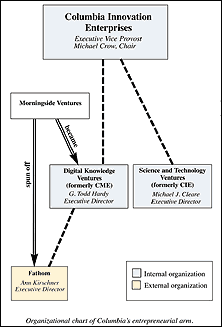 |
 |
 |
 |
|
FEATURE
With the rise of digital media, however, that situation has changed. Columbia and other universities are investing millions of dollars in technology infrastructure, digital resources and training, and the opportunities for faculty to profit from providing content to the new media world have mushroomed. "With digital media, people are coming out of the woodwork trying to be the portal for education. We don't want our faculty members to be picked off," says Todd Hardy, executive director of Digital Knowledge Ventures, a second technology transfer office that was opened specifically to handle new media projects. To clarify who owns what, last summer the University followed the example of schools like Stanford and the University of Chicago and adopted a comprehensive copyright policy. "Knowledge is a very valuable asset. We want to make sure it's used for Columbia's purposes and that people here and in the Columbia community benefit from it," says Provost Jonathan Cole '64. "Faculty wanted clarification as much as the University did." "Faculty have been interested in or concerned about the electronic media side of things for some time," says Professor of History Richard Bulliet. "I remember getting queries from a couple of media companies myself and replying, 'I don't know. My university hasn't articulated a policy.'" Existing policies regarding intellectual property concentrated on income from patents or licensing agreements resulting from research done on campus. The 1980 Bayh-Dole Act required each university receiving federal funding for research to set up a technology transfer office and use the income for education and research purposes. For the past 17 years, Columbia's office has reviewed hundreds of proposals from faculty and shepherded dozens of products - from a video tour of Amiens cathedral to the glaucoma drug Xalatan - to the marketplace, and brought millions of dollars back home.
As for the less obviously commercial output like books and outside lectures, professors have traditionally owned those rights. But with digital media come higher stakes. Columbia did not want its name put on Internet courses over which it did not have control, for example. "If we are not careful, if individual Schools or faculty members act as 'free agents' and neglect our collective need to maintain standards of quality, we may do damage to the University as a whole," wrote President George Rupp in a letter to the University community last February. A draft of the new intellectual property policy was circulated on campus last spring by e-mail and posted on an internal Web site for comments. "There weren't a lot of major conflicts" over the policy's provisions, says Raphael Kasper, associate vice provost for research. "Most agreed that if the University puts substantial resources into the creation of work, it should have some rights of ownership." According to the policy, professors continue to own the rights to traditionally published materials. In addition, they will own the rights to new media content that was developed with the shared resources generally provided to all members of the University community. University ownership kicks in when content has been created using resources "beyond the level of common resources provided to faculty." The definition of a common resource versus a substantial one was left deliberately vague to reflect the rapidly changing area of new media itself. "Nobody can anticipate the future," Bulliet says. "And what is considered a substantial resource can vary within programs. One department may find computer stuff completely eccentric and new and fancy, and another may see it as completely normal." A Q&A is appended to the policy and will grow as cases are presented to a copyright review committee that was formed with the policy. "Faculty still have free rein to give lectures, talks and presentations, they just can't commercialize anything. They can't do a Web course," says Michael Crow, executive vice provost. Kasper gives the example of the Brownfield Action Project (CCT, December 2000), an interactive project developed in large part by the Center for New Media Teaching and Learning for a science class at Barnard, as something that required substantial resources. In cases where the Uuniversity owns the intellectual property, 25 to 50 percent of the net profits are returned to the inventor, with another 25-30 percent going back to his or her research.
|
|
|||||||||||||||||||||||||||||||||||||||||||||||||||||||||||||||||||||||||||||||




